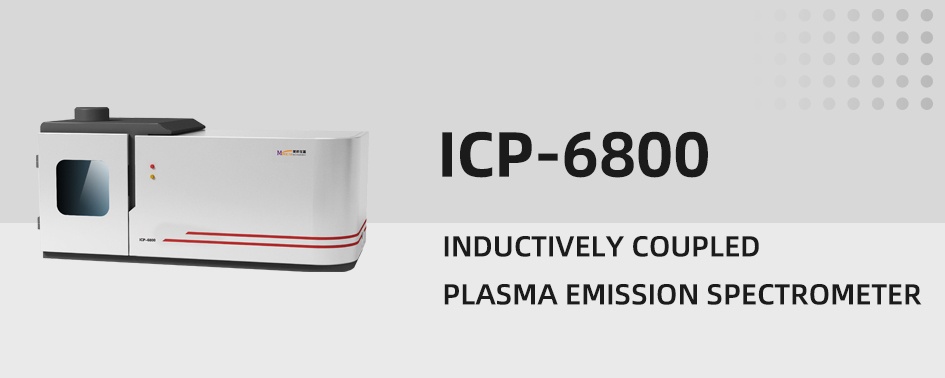Determination scheme of potassium oxide and sodium oxide in vanadium pentoxide (ICP-AES)
Introduction: Vanadium is a non-ferrous metal. Vanadium pentoxide is widely used in metallurgy, chemical industry and other industries, mainly for smelting ferrovanadium. It is used as alloy additive, accounting for more than 80% of the total consumption of vanadium pentoxide, followed by organic chemical catalyst, i.e. catalyst, accounting for about 10% of the total, and inorganic chemicals, chemical reagents, enamel and magnetic materials, accounting for about 10% of the total.

This scheme is applicable to the determination of potassium oxide and sodium oxide in vanadium pentoxide. Determination range (mass fraction): potassium oxide, 0.05% ~ 0.8%; Sodium oxide, 0.1% ~ 2%.
Principle
After the sample is decomposed with hydrochloric acid at low temperature, V in hydrochloric acid medium, dilute the test solution to a certain volume, measure the spectral intensity of each element on the inductively coupled plasma emission spectrometer, calculate the mass concentration of potassium oxide and sodium oxide in the sample on the calibration curve, and then calculate its mass fraction.
The scheme is based on Yb / T 4220-2010
Instruments and reagents
American analysis icp-6800 inductively coupled plasma emission spectrometer
Only use reagents and distilled water confirmed as analytical purity or water equivalent to its purity
VzO5,≥99.99%。
Hydrochloric acid (1 + 2)
Potassium oxide standard solution: accurately weigh 0.3957g of reference potassium chloride, which is burned at 500 ℃ for 0.5h and cooled to room temperature in a dryer, and place it in 300ml In the beaker, add 100ml of water, dissolve it completely, and add human? 5ml hydrochloric acid (1 + 2), transfer to 250ml volumetric flask, dilute with water to the scale, and mix well. LML of this solution contains 1.00mg potassium oxide
Sodium oxide standard solution: accurately weigh 0.4715g of reference sodium chloride, which has been burned at 50O ℃ for 0.5h and cooled to room temperature in a dryer, put it into a 300ml beaker, add 100ml of water, dissolve it completely, add 5ml of hydrochloric acid (1 + 2), transfer it to a 250ml volumetric flask, dilute it with water to the scale, and mix it evenly. 1ml of this solution contains 1.00mg sodium oxide
Mixed standard solution: transfer 50.00ml potassium oxide standard solution and 100.00ml sodium oxide standard solution into a 200mi volumetric flask, dilute with water to the scale, and mix well. 1ml of this solution contains 250ug potassium oxide and 500ug sodium oxide.
Analysis steps
Weigh 0.250g Sample, accurate to 0.0001g. Blank test shall be carried out along with the sample. Put the sample into a 100ml conical flask, add 30ml hydrochloric acid (2 + 1), heat at low temperature to completely dissolve the sample, concentrate the volume to nearly dry (residual volume is about 1ml ~ 2ml), and take it down. Add 15ml hydrochloric acid (1 + 2) and 30ml water and heat to completely dissolve the salt. Cool to room temperature, transfer into a 100ml volumetric flask, dilute with water to the scale, and mix well. Stand still, take the supernatant and test it on ICP spectrum analyzer
Recommended analysis line
Element K analysis Harmonic / nm766 four hundred and ninety-one
Na analysis Harmonic / nm589 592,588.995
Take and prepare samples according to Yb / T 5304. The sample shall pass through the 0.125mm sieve. The test material shall be dried at 105 ℃ ~ 110 ℃ for 2h in advance and cooled to room temperature in a drye
Determination
Start the inductively coupled plasma emission spectrometer and preheat it for at least 1H before measurement. After the instrument is stable, select the analytical spectral lines of potassium and sodium, and measure the spectral line intensity of potassium oxide and sodium oxide in turn. Subtract the strength of the blank test solution to be the net strength, and calculate the mass concentration of potassium oxide or sodium oxide on the calibration curve
Drawing of calibration curve
Preparation of calibration curve series: weigh 0.2500g? Place 6 parts of high-purity vanadium pentoxide (4.1) in 100ml conical flask respectively, add 8ml hydrochloric acid (2 + 1), heat to dissolve the sample completely and evaporate until the test solution is nearly dry, heat to dissolve the salt with 15ml hydrochloric acid (4.3), cool to room temperature, transfer them to 6 100ml volumetric flasks respectively, add 0ml, 2.00ml, 4.00ml, 6.00ml, 8.00ml and 10.00ml mixed standard solution in sequence, dilute with water to the scale and mix well.
Test and draw calibration curve
Test the calibration curve series solution on the ICP spectrum analyzer. The strength of each solution in the calibration curve series minus the strength of the zero concentration solution is the net strength of the calibration curve series solution of each measured element. Take the concentration of each measured element (g / ml) as the abscissa and the net strength as the ordinate to draw the calibration curve.
Calculation of analysis results
Calculate the content (mass fraction) w (KO, NAO) of potassium oxide or sodium oxide in the sample according to the formula, and the value is expressed in%:
In the formula:
ρ——The mass concentration of sodium oxide or potassium oxide in the sample solution found on the self calibration curve, in micrograms per milliliter (UG / ml)
v——Finally measure the volume of sample solution, in milliliter (ML);
M0——Sample quantity, in gram (g)




